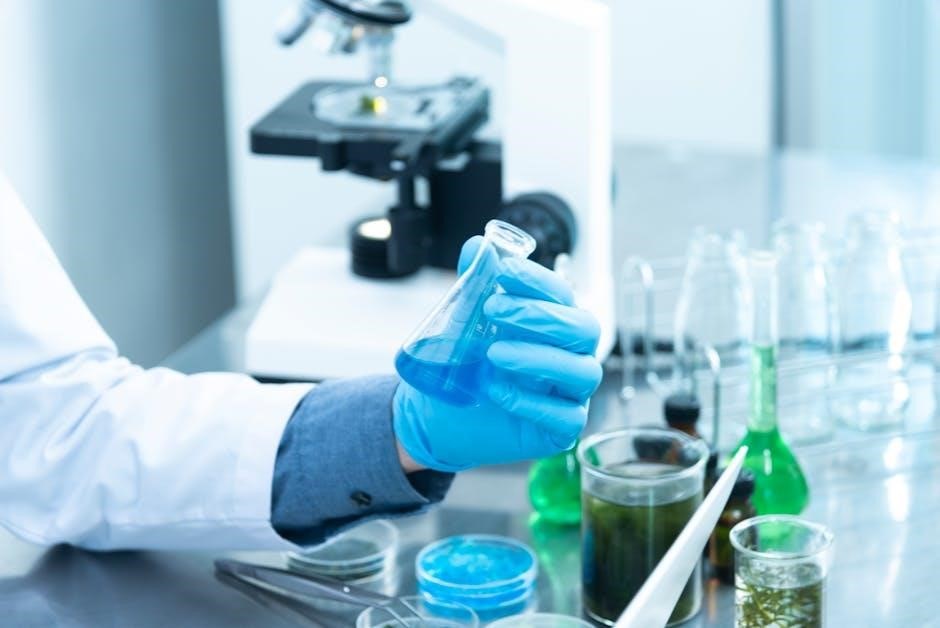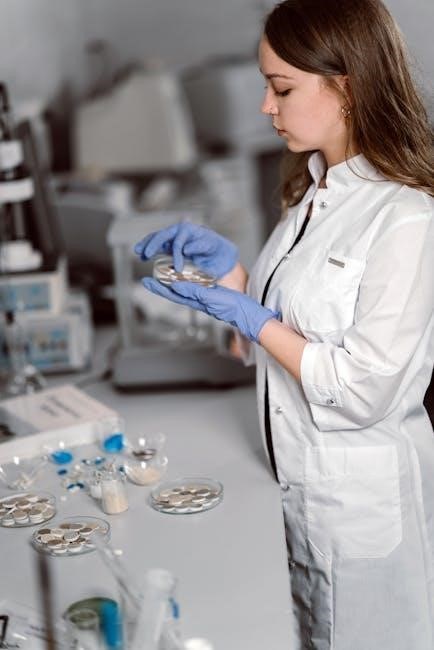chemistry 1050 lab manual answers
The Chemistry 1050 Lab Manual is a comprehensive guide for students‚ providing detailed procedures and answers for experiments like water alkalinity and density measurements. It emphasizes safety protocols‚ data analysis‚ and problem-solving strategies to enhance learning outcomes.
Overview of the Lab Manual
The Chemistry 1050 Lab Manual serves as a detailed guide for students‚ offering step-by-step procedures‚ post-lab questions‚ and answers to experiments like water alkalinity and density measurements. It covers essential safety protocols‚ emphasizing proper lab practices to ensure a secure learning environment. The manual includes sections on key concepts such as electrolysis‚ solubility‚ and titration‚ providing a foundational understanding of chemical principles. Additionally‚ it addresses data analysis techniques‚ error calculations‚ and graphical representations to help students interpret their results effectively. Practical problem-solving strategies and common mistakes are highlighted to enhance student performance and comprehension throughout the course.
Importance of Lab Work in Chemistry 1050
Lab work in Chemistry 1050 is essential for applying theoretical concepts to real-world scenarios‚ enhancing understanding and practical skills. Experiments like determining water alkalinity and density measurements provide hands-on experience‚ reinforcing chemical principles. Labs foster critical thinking‚ problem-solving‚ and teamwork‚ preparing students for future scientific challenges. They also develop data analysis skills‚ teaching students to interpret results and address errors. By conducting experiments‚ students gain a deeper appreciation for chemical processes and safety protocols‚ equipping them with the confidence and expertise needed for advanced studies and professional applications in chemistry.

Safety Protocols in the Chemistry Lab
Adhering to safety protocols is crucial in the chemistry lab. Wear goggles‚ gloves‚ and lab coats to prevent exposure to hazardous chemicals. Ensure emergency exits are accessible and eyewashes are nearby. Follow proper handling and disposal procedures for chemicals. Familiarize yourself with fire extinguishers and emergency shower locations. Report accidents immediately to prevent further harm. Proper ventilation is essential when working with volatile substances. Always read and follow safety data sheets (SDS) for each chemical used in experiments. Maintain a clean workspace to minimize risks and ensure a secure environment for everyone.
General Safety Guidelines
General safety guidelines in the chemistry lab are essential to ensure a safe working environment. Always wear appropriate personal protective equipment‚ including goggles‚ gloves‚ and a lab coat‚ to protect against chemical splashes and spills. Ensure long hair and loose clothing are tied back‚ and avoid wearing open-toed shoes. Familiarize yourself with the location of emergency equipment‚ such as fire extinguishers‚ eyewashes‚ and emergency showers. Read and follow the safety data sheets (SDS) for all chemicals used in experiments. Never taste or smell chemicals‚ and avoid touching substances without proper protection. Keep the workspace clean and organized to prevent accidents. Dispose of chemical waste properly‚ following lab protocols. Be attentive to your surroundings and report any unsafe conditions immediately.
Emergency Procedures
In case of emergencies‚ immediate action is crucial to ensure safety. For chemical spills‚ contain the area‚ wear protective gear‚ and follow cleanup procedures. In case of a fire‚ use the appropriate fire extinguisher and evacuate the area. If skin or eyes are exposed to chemicals‚ flush with water for at least 15 minutes and seek medical attention. For inhalation of harmful fumes‚ move to fresh air and provide oxygen if necessary. Know the locations of emergency equipment‚ such as eyewashes‚ showers‚ and fire extinguishers. Stay calm‚ follow lab protocols‚ and alert others in the vicinity. Always prioritize safety and act swiftly to prevent further incidents.

Experiments in Chemistry 1050
Experiments in Chemistry 1050 focus on practical applications of chemical concepts‚ including determining water alkalinity and density measurements. These labs enhance understanding of chemical properties and techniques.
Experiment 1: Determining the Alkalinity of Water
This experiment focuses on measuring the alkalinity of water using titration methods. Students titrate water samples with hydrochloric acid (HCl) to determine the concentration of hydroxide ions (OH⁻)‚ bicarbonate ions (HCO₃⁻)‚ and carbonate ions (CO₃²⁻). The process involves adding a known concentration of HCl to the water sample until the pH reaches a specific endpoint‚ typically using phenolphthalein as an indicator. The volume of HCl used and the initial concentration are used to calculate the total alkalinity. This experiment helps students understand the importance of water quality analysis and the principles of acid-base titration. Post-lab questions focus on interpreting results and understanding sources of error.
Objective
The objective of this experiment is to determine the alkalinity of water by measuring the concentration of hydroxide (OH⁻)‚ bicarbonate (HCO₃⁻)‚ and carbonate (CO₃²⁻) ions. Students will perform an acid-base titration using hydrochloric acid (HCl) to neutralize the alkaline species in the water sample. The endpoint of the titration is determined using phenolphthalein as an indicator. By calculating the volume and concentration of HCl used‚ students can determine the total alkalinity of the water. This experiment introduces students to titration techniques and reinforces concepts of acid-base chemistry and stoichiometry. It also emphasizes the importance of accurate measurements and data analysis in water quality assessment.
Materials and Procedure
Materials include distilled water‚ sodium hydroxide (NaOH)‚ sodium carbonate (Na₂CO₃)‚ hydrochloric acid (HCl)‚ phenolphthalein‚ burettes‚ volumetric flasks‚ and glassware. The procedure involves standardizing NaOH by titrating it against HCl. Students then prepare a water sample by adding Na₂CO₃ to simulate alkalinity. The sample is titrated with standardized NaOH to determine hydroxide‚ bicarbonate‚ and carbonate ion concentrations. Phenolphthalein indicates the endpoint. Calculations involve stoichiometric relationships to find ion concentrations and total alkalinity. Proper handling of acids and bases is emphasized‚ along with accurate measurements and data recording. This procedure helps students master titration techniques and understand alkalinity determination in water analysis.
Post-Lab Questions
- What evidence did you observe to confirm the endpoint of the titration?
- Calculate the concentration of hydroxide‚ bicarbonate‚ and carbonate ions in the water sample. How does this relate to total alkalinity?
- What sources of error could affect your calculations‚ and how can they be minimized?
- Explain the purpose of standardizing the NaOH solution before titration.
- How does the addition of Na₂CO₃ simulate natural water alkalinity?

Experiment 2: Density Measurements
In Experiment 2‚ students measure the density of various liquids and solids to understand this fundamental property. The procedure involves calculating density using mass and volume measurements. Materials include a balance‚ graduated cylinder‚ and hydrometer. Students record mass with an empty and filled container‚ then compute density. The hydrometer provides a direct measurement‚ ensuring accuracy. Temperature control is crucial‚ as density varies with temperature. Safety precautions and proper waste disposal are emphasized. The lab reinforces concepts of precision‚ significant figures‚ and error analysis‚ preparing students for real-world applications in chemistry. Post-lab questions help solidify understanding of density and measurement techniques.
The objective of Experiment 1 is to determine the alkalinity of water using titration methods. Students will learn to measure the concentration of hydroxide ions in water and calculate its alkalinity. This experiment introduces titration techniques‚ emphasizing accuracy and precision. By comparing experimental results with theoretical values‚ students gain hands-on experience in analytical chemistry. The lab also highlights the importance of water quality assessment in environmental chemistry. Understanding alkalinity is crucial for evaluating water hardness and its effects on industrial and domestic use. This experiment builds foundational skills in laboratory procedures‚ data interpretation‚ and error analysis‚ essential for advanced chemistry studies.
Materials include distilled water‚ 0.01 M NaOH solution‚ phenolphthalein indicator‚ 50 mL burette‚ 25 mL volumetric flask‚ and glassware. The procedure involves preparing the water sample‚ setting up the burette with NaOH‚ and adding a few drops of phenolphthalein to the water. Students titrate until the solution turns pink‚ recording initial and final burette readings. The volume of NaOH used is calculated to determine water alkalinity. Proper handling and measurement techniques are emphasized to ensure accurate results. This hands-on approach helps students master titration methods and data interpretation‚ aligning with the lab’s educational goals.
Calculate the alkalinity of the water sample using the volume of NaOH used and its molarity.
Discuss potential sources of error in the titration process.
Explain the role of phenolphthalein as an indicator in this experiment.
How does the alkalinity of water relate to its hardness?
What are the implications of high alkalinity in drinking water?
These questions help students analyze their results‚ understand the chemical principles involved‚ and connect the experiment to real-world applications. They also encourage critical thinking about experimental accuracy and environmental relevance. Addressing these questions enhances comprehension of titration methods and water chemistry concepts.

Key Concepts and Techniques
The Chemistry 1050 Lab Manual covers key techniques such as electrolysis‚ solubility studies‚ and titration methods‚ essential for understanding chemical properties and reactions.
Electrolysis and Its Applications
Electrolysis is a fundamental process in chemistry where electrical energy drives non-spontaneous chemical reactions. In the Chemistry 1050 lab‚ students explore electrolysis through experiments like the decomposition of water into hydrogen and oxygen. This technique is widely used in industries for metal extraction‚ electroplating‚ and purification. The lab manual provides detailed procedures for setting up electrolytic cells and calculating the amount of products formed. Understanding electrolysis enhances comprehension of electrochemical cells and redox reactions‚ crucial for advanced chemistry studies. Practical applications include battery manufacturing and wastewater treatment‚ highlighting its real-world significance. The manual also includes post-lab questions to reinforce concepts and ensure mastery of electrolysis principles.
Solubility and Solutions
Solubility refers to the ability of a substance to dissolve in a solvent‚ forming a homogeneous solution. In the Chemistry 1050 lab‚ students investigate solubility through experiments like titration and saturation tests. The lab manual provides detailed procedures for determining solubility constants and analyzing solution composition. Key concepts include the role of temperature‚ pressure‚ and solvent type in affecting solubility. Practical applications‚ such as pharmaceutical formulations and industrial processes‚ are explored; Post-lab questions focus on interpreting solubility data and understanding the factors influencing solution stability. This section enhances students’ understanding of chemical equilibria and solution chemistry‚ essential for advanced topics in analytical and physical chemistry.
Titration Methods
Titration methods are fundamental in analytical chemistry for determining the concentration of unknown solutions. In the Chemistry 1050 lab‚ students learn acid-base titration techniques‚ involving the reaction of a known concentration of acid or base with an unknown solution. The process uses a burette to measure the volume of titrant required to reach the equivalence point‚ identified by a color change in an indicator. Key concepts include stoichiometry‚ equivalence points‚ and precision in measurements. Common titration types include strong acid-strong base‚ strong acid-weak base‚ and weak acid-strong base reactions. The lab manual provides detailed procedures‚ calculations‚ and post-lab questions to ensure mastery of titration principles and their applications in real-world scenarios.

Data Analysis and Interpretation
Data analysis involves calculating concentrations‚ analyzing errors‚ and interpreting results from experiments. Graphical representation of data helps visualize trends and compare theoretical vs. experimental values effectively.
Calculations and Error Analysis
Accurate calculations are crucial in chemistry experiments‚ such as determining concentrations‚ volumes‚ and molarities. Error analysis helps identify sources of inaccuracy‚ like measurement deviations or instrument limitations. Students learn to calculate percent error and error propagation‚ ensuring reliable results. Understanding these concepts improves data interpretation and experimental design. Graphical methods‚ such as plotting concentration vs. volume‚ visually represent trends and relationships‚ aiding in identifying anomalies. These skills are essential for valid conclusions and problem-solving in chemistry. By mastering calculations and error analysis‚ students enhance their ability to interpret experimental outcomes effectively and apply these techniques in future scientific endeavors.
Graphical Representation of Data
Graphical representation of data is essential for clear and effective communication of experimental results. Line graphs‚ bar charts‚ and scatter plots are commonly used to visualize trends and relationships. For example‚ plotting concentration vs. volume in titration experiments helps identify equivalence points. Students learn to create accurate graphs with proper labels‚ titles‚ and legends. These visual tools aid in identifying patterns‚ anomalies‚ and correlations‚ facilitating data interpretation. Graphing also enhances understanding of concepts like solubility‚ density‚ and chemical reactions. By analyzing graphs‚ students can draw meaningful conclusions and present their findings professionally‚ which is a critical skill in scientific reporting and problem-solving.

Problem-Solving Strategies
Developing strong problem-solving skills is crucial in chemistry. Students learn to approach lab questions systematically‚ analyze data‚ and apply concepts to find solutions. Practice helps build confidence and accuracy.
Approaching Lab Questions
Approaching lab questions in Chemistry 1050 requires a systematic and analytical mindset. Start by thoroughly reading the lab manual to understand the experiment’s objective and procedures. Identify key variables‚ expected outcomes‚ and potential sources of error. Review relevant concepts from lectures and textbooks to connect theory with practical observations. When analyzing data‚ focus on accuracy and precision‚ ensuring calculations are correct and results are logically interpreted. Practice answering post-lab questions by referencing sample problems and solutions provided in the lab manual or online resources. Seek clarification from instructors or peers when faced with challenges. Regular practice and reflection on common mistakes will enhance problem-solving skills and improve lab performance.
Common Mistakes and Solutions
Common mistakes in Chemistry 1050 labs often include inaccurate measurements‚ improper use of equipment‚ and misinterpretation of data. Students may forget to calibrate instruments or miscalculate concentrations‚ leading to erroneous results. To avoid these errors‚ ensure precise measurements using appropriate tools and double-check calculations. Familiarize yourself with equipment operation to prevent mishandling. When analyzing data‚ verify that conclusions align with observed results. Reviewing lab procedures and seeking guidance from instructors can mitigate these issues. Additionally‚ practicing time management during experiments helps prevent rushed‚ error-prone work. Addressing these common pitfalls enhances lab efficiency and accuracy‚ fostering a better understanding of chemical principles.
The Chemistry 1050 lab manual provides essential hands-on experience‚ reinforcing theoretical concepts through practical experiments and fostering analytical thinking‚ preparing students for advanced chemical studies and real-world applications.
The Chemistry 1050 lab manual offers a structured approach to hands-on learning‚ with experiments like determining water alkalinity and density measurements. These labs enhance understanding of chemical principles‚ fostering critical thinking and practical skills. Students gain experience in data collection‚ analysis‚ and error interpretation‚ as well as safe lab practices. The manual’s clear procedures and post-lab questions reinforce concepts‚ ensuring a strong foundation in chemistry. Through these experiences‚ students develop problem-solving abilities and confidence in conducting scientific investigations‚ preparing them for future academic and professional challenges in STEM fields.
Future Applications of Learned Skills
The skills acquired through the Chemistry 1050 lab manual are invaluable for future academic and professional endeavors. Students develop proficiency in titration‚ density measurements‚ and error analysis‚ which are essential in research and industrial chemistry. The ability to interpret data and solve problems enhances critical thinking‚ applicable in fields like environmental science and engineering. Laboratory safety protocols learned here ensure preparedness for real-world lab environments. Additionally‚ the understanding of chemical principles and experimental design can benefit careers in healthcare‚ quality control‚ and education. These skills provide a solid foundation for tackling complex challenges and advancing scientific knowledge in various disciplines.

Additional Resources
Supplement your learning with recommended textbooks‚ online tools‚ and tutorials. Resources like Quizlet‚ study guides‚ and university-provided materials enhance understanding and mastery of lab concepts effectively.
- Textbooks and manuals for in-depth explanations;
- Online platforms for interactive learning.
- Study guides for focused revision.
Recommended Textbooks and Manuals
For Chemistry 1050‚ several textbooks and manuals are highly recommended to complement lab work. Titles like Chemistry: An Atoms First Approach by Steven S. Zumdahl and General Chemistry: Principles‚ Patterns‚ and Applications by A.A. González provide in-depth explanations. The Chemistry 1050 Laboratory Manual is essential for experiment procedures and answers. Additional resources include Study Guides and Solutions Manuals‚ which offer step-by-step solutions to problems. Online platforms like Quizlet and university libraries also provide access to digital versions. These materials ensure a comprehensive understanding of key concepts‚ experiments‚ and data analysis techniques. They are available at university bookstores or online marketplaces for easy access.
- Chemistry: An Atoms First Approach by Steven S. Zumdahl
- General Chemistry: Principles‚ Patterns‚ and Applications by A.A. González
- Chemistry 1050 Laboratory Manual
- Study Guides and Solutions Manuals
Online Tools and Tutorials
Several online tools and tutorials are available to support learning in Chemistry 1050. Platforms like Quizlet offer flashcards and study guides for key concepts. Study.com provides video tutorials and practice problems. Khan Academy features free chemistry lessons and exercises. Additionally‚ online forums and university resources‚ such as Ares and course reserves‚ provide access to lab manuals and solutions. These tools enhance understanding and preparation for exams and lab work. Many universities also offer virtual labs and simulations to complement hands-on experiments. Online resources are accessible 24/7‚ making them ideal for self-paced learning and review.
- Quizlet for flashcards and study guides
- Study.com for video tutorials and practice problems
- Khan Academy for free chemistry lessons


